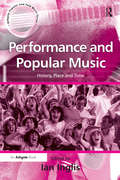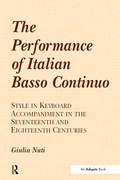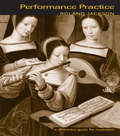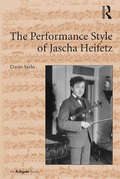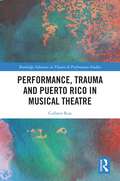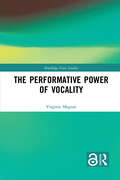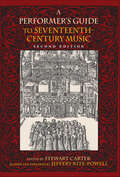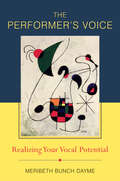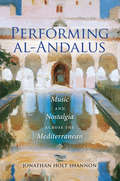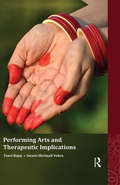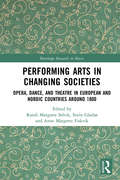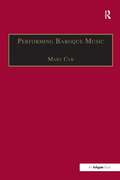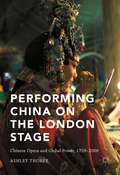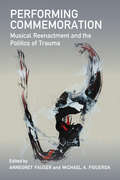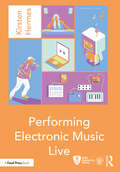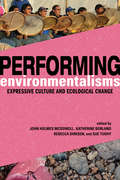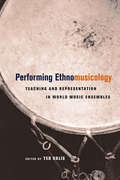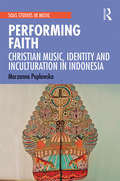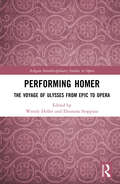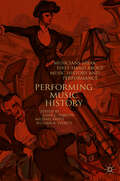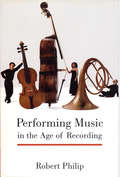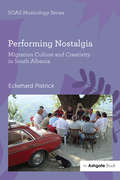- Table View
- List View
Performance and Popular Music: History, Place and Time (Ashgate Popular And Folk Music Ser.)
by Ian InglisSince the emergence of rock'n'roll in the early 1950s, there have been a number of live musical performances that were not only memorable in themselves, but became hugely influential in the way they shaped the subsequent trajectory and development of popular music. Each, in its own way, introduced new styles, confronted existing practices, shifted accepted definitions, and provided templates for others to follow. Performance and Popular Music explores these processes by focusing on some of the specific occasions when such transformations occurred. An international array of scholars reveal that it is through the (often disruptive) dynamics of performance - and the interaction between performer and audience - that patterns of musical change and innovation can best be recognised. Through multi-disciplinary analyses which consider the history, place and time of each event, the performances are located within their social and professional contexts, and their immediate and long-term musical consequences considered. From the Beatles and Bob Dylan to Michael Jackson and Madonna, from Woodstock and Monterey to Altamont and Live Aid, this book provides an indispensable assessment of the importance of live performance in the practice of popular music, and an essential guide to some of the key moments in its history.
The Performance of Italian Basso Continuo: Style in Keyboard Accompaniment in the Seventeenth and Eighteenth Centuries
by Giulia NutiBasso continuo accompaniment calls upon a complex tapestry of harmonic, rhythmic, compositional, analytical and improvisational skills. The evolving knowledge that underpinned the performance of basso continuo was built up and transmitted from the late 1500s to the second half of the eighteenth century, when changes in instruments together with the assertion of control by composers over their works brought about its demise. By tracing the development of basso continuo over time and across the regions of Italy where differing practices emerged, Giulia Nuti accesses this body of musical usage. Sources include the music itself, introductions and specific instructions and requirements in song books and operas, contemporary accounts of performances and, in the later period of basso continuo, description and instruction offered in theoretical treatises. Changes in instruments and instrumental usage and the resulting sounds available to composers and performers are considered, as well as the altering relationship between the improvising continuo player and the composer. Extensive documentation from both manuscript and printed sources, some very rare and others better known, in the original language, followed by a precise English translation, is offered in support of the arguments. There are also many musical examples, transcribed and in facsimile. Giulia Nuti provides both a scholarly account of the history of basso continuo and a performance-driven interpretation of how this music might be played.
The Performance of Jewish and Arab Music in Israel Today: A special issue of the journal Musical Performance
by Amnon ShiloahIsrael, with its highly heterogeneous immigrant society, offers to the observer a fascinating instance of multifaceted performance practice. Within a relatively limited area, there are numerous musical traditions and styles which encompass sacred and secular, old and new, folk and sophisticated forms. The ten contributions included in these issues of Musical Performance represent a discussion of the most significant traditions that were established during the period before 1948: the search for the establishment of a new and typically Israeli art and folk music; the attitude of the protagonists of this tendency toward the old exiled traditional heritage of the Jewish people, and the struggle of the immigrants after the creation of the State of Israel to ensure the survival of their musical tradtions as well as to cope with the new physical and cultural environment. Altogether the general scope of these contributions correspond to a large extent to major events which marked the m
Performance Practice: A Dictionary-Guide for Musicians
by Roland JacksonPerformance practice is the study of how music was performed over the centuries, both by its originators (the composers and performers who introduced the works) and, later, by revivalists. This first of its kind Dictionary offers entries on composers, musiciansperformers, technical terms, performance centers, musical instruments, and genres, all aimed at elucidating issues in performance practice. This A-Z guide will help students, scholars, and listeners understand how musical works were originally performed and subsequently changed over the centuries. Compiled by a leading scholar in the field, this work will serve as both a point-of-entry for beginners as well as a roadmap for advanced scholarship in the field.
The Performance Style of Jascha Heifetz
by Dario SarloThe violinist Jascha Heifetz (1901-1987) is considered among the most influential performers in history and still maintains a strong following among violinists around the world. Dario Sarlo contributes significantly to the growing field of analytical research into recordings and the history of performance style. Focussing on Heifetz and his under-acknowledged but extensive performing relationship with the Bach solo violin works (BWV 1001-1006), Sarlo examines one of the most successful performing musicians of the twentieth century along with some of the most frequently performed works of the violin literature. The book proposes a comprehensive method for analysing and interpreting the legacies of prominent historical performers in the wider context of their particular performance traditions. The study outlines this research framework and addresses how it can be transferred to related studies of other performers. By building up a comprehensive understanding of multiple individual performance styles, it will become possible to gain deeper insight into how performance style develops over time. The investigation is based upon eighteen months of archival research in the Library of Congress’s extensive Jascha Heifetz Collection. It draws on numerous methods to examine what and how Heifetz played, why he played that way, and how that way of playing compares to other performers. The book offers much insight into the ’music industry’ between 1915 and 1975, including touring, programming, audiences, popular and professional reception and recording. The study concludes with a discussion of Heifetz’s unique performer profile in the context of violin performance history.
Performance, Trauma and Puerto Rico in Musical Theatre (Routledge Advances in Theatre & Performance Studies)
by Colleen RuaThis study positions four musicals and their associated artists as mobilizers of defiant joy in relation to trauma and healing in Puerto Rico. The book argues that the historical trajectory of these musicals has formed a canon of works that have reiterated, resisted or transformed experiences of trauma through linguistic, ritual, and geographic interventions. These traumas may be disaster-related, migrant-related, colonial or patriarchal. Bilingualism and translation, ritual action, and geographic space engage moments of trauma (natural disaster, incarceration, death) and healing (community celebration, grieving, emancipation) in these works. The musicals considered are West Side Story (1957, 2009, 2019); The Capeman (1998); In the Heights (2008); and Hamilton (2015). Central to this argument is that each of the musicals discussed is tied to Puerto Rico, either through the representation of Puerto Rican characters and stories, or through the Puerto Rican positionality of its creators. The author moves beyond the musicals to consider Lin-Manuel Miranda as an embodied site of healing, that has been met with controversy, as well as posthurricane Maria relief efforts led by Miranda on the island and from a distance. In each of the works discussed, acts of belonging shape notions of survivorship and witness. This book also opens a dialogue between these musicals and the work of island-based artists Y no había luz, that has served as sites of first response to disaster. This book will be of interest to students and scholars in Latinx Theatre, Musical Theatre and Translation studies.
The Performative Power of Vocality (Routledge Voice Studies)
by Virginie MagnatThe Performative Power of Vocality offers a fresh perspective on voice as a subject of critical inquiry by employing an interdisciplinary and cross-cultural approach. Conventional treatment of voice in theatre and performance studies too often regards it as a subcategory of actor training, associated with the established methods that have shaped voice pedagogy within Western theatre schools, conservatories, and universities. This monograph significantly deviates from these dominant models through its investigation of the non-discursive, material, and affective efficacy of vocality, with a focus on orally transmitted vocal traditions. Drawing from her performance training, research collaborations, and commitment to cultural diversity, Magnat proposes a dialogical approach to vocality. Inclusive of established, current, and emerging research perspectives, this approach sheds light on the role of vocality as a vital source of embodied knowledge, creativity, and well-being grounded in process, practice, and place, as well as a form of social and political agency. An excellent resource for qualitative researchers, artist-scholars, and activists committed to decolonization, cultural revitalization, and social justice, this book opens up new avenues of understanding across Indigenous and Western philosophy, performance studies, musicology, ethnomusicology, sound and voice studies, anthropology, sociology, phenomenology, cognitive science, physics, ecology, and biomedicine.
A Performer's Guide to Renaissance Music (Publications of the Early Music Institute)
by Jeffery Kite-PowellRevised and expanded since it first appeared in 1991, the guide features two new chapters on ornamentation and rehearsal techniques, as well as updated reference materials, internet resources, and other new material made available only in the last decade.The guide is comprised of focused chapters on performance practice issues such as vocal and choral music; various types of ensembles; profiles of specific instruments; instrumentation; performance practice issues; theory; dance; regional profiles of Renaissance music; and guidelines for directors. The format addresses the widest possible audience for early music, including amateur and professional performers, musicologists, theorists, and educators.
A Performer's Guide to Seventeenth-Century Music (Publications of the Early Music Institute)
by Jeffery Kite-PowellRevised and expanded, A Performer's Guide to Seventeenth Century Music is a comprehensive reference guide for students and professional musicians. The book contains useful material on vocal and choral music and style; instrumentation; performance practice; ornamentation, tuning, temperament; meter and tempo; basso continuo; dance; theatrical production; and much more. The volume includes new chapters on the violin, the violoncello and violone, and the trombone—as well as updated and expanded reference materials, internet resources, and other newly available material. This highly accessible handbook will prove a welcome reference for any musician or singer interested in historically informed performance.
The Performer's Voice: Realizing Your Vocal Potential
by Meribeth DaymeAn essential guide to how the voice works; and how to realize its potential. Concise, accurate, and accessible, The Performer's Voice explains how the voice works and how to use it efficiently. Emphasizing the infinite potential of the human voice, this practical book enables vocal professionals to use their voices effectively to create dynamic performances. Written for people who use their voices every day; from singers, actors, and teachers to trial lawyers, ministers, and radio announcers; The Performer's Voice brings together the basic anatomy, physiology, technique, and performance skills required for effective use of the voice. Simple exercises and observations, designed for busy people to do in a short time, provide practical application. Anatomically correct drawings support concise, direct explanations. Taking a balanced, common sense approach, this book provides simple guidelines for using the voice healthily and imaginatively. For anyone who relies on the voice for a living,The Performer's Voice provides the essential tools for confident, imaginative and compelling performances.
Performing al-Andalus
by Jonathan Holt ShannonPerforming al-Andalus explores three musical cultures that claim a connection to the music of medieval Iberia, the Islamic kingdom of al-Andalus, known for its complex mix of Arab, North African, Christian, and Jewish influences. Jonathan Holt Shannon shows that the idea of a shared Andalusian heritage animates performers and aficionados in modern-day Syria, Morocco, and Spain, but with varying and sometimes contradictory meanings in different social and political contexts. As he traces the movements of musicians, songs, histories, and memories circulating around the Mediterranean, he argues that attention to such flows offers new insights into the complexities of culture and the nuances of selfhood.
Performing Arts and Therapeutic Implications
by Tanvi Bajaj Swasti Shrimali VohraPresenting an alternative perspective, this book proposes that performing arts forge an emotional bond between the performer and the audience, making the act of performance a therapeutic and restorative experience, and not merely recreational. Studying the life-experiences of six artists, and their unique engagement with three art forms — music, drama and dance — the book highlights the physical, emotional, mental, and spiritual effects of performing arts both on the performers and the audience. More importantly, it takes the current understanding of the therapeutic role of arts beyond a deficit model of health that focuses on their use in curing illnesses, disabilities and imbalances, towards a more positive growth-centric model that relates them to promoting holistic mental health, well-being and happiness. It thus bridges the gap between the theoretical understanding of creative arts therapy and the practical experience of performing arts in non-therapeutic settings. Further, it assumes increasing relevance with respect to fast-changing lifestyles to which stress and ill-health are often attributed. The book will appeal to artists, educators and researchers of performing arts, applied psychology, counselling and therapy, and cultural studies, as well as interested general readers.
Performing Arts in Changing Societies: Opera, Dance, and Theatre in European and Nordic Countries around 1800 (Routledge Research in Music)
by Randi Margrete SelvikPerforming Arts in Changing Societies is a detailed exploration of genre development within the fields of dance, theatre, and opera in selected European countries during the decades before and after 1800. An introductory chapter outlines the theoretical and ideological background of genre thinking in Europe, starting from antiquity. A further fourteen chapters cover the performing genres as they developed in England, France, Germany, and Austria, and follow the dissemination and adaptation of the corresponding genres in minor and major cities in the Nordic countries. With a strong emphasis on the role that pragmatic and contextual factors had in defining genres, the book examines such subjects as the dancing masters in Christiania (Oslo), circa 1800, the repertory and travels of an itinerant acrobat and his wife in Norway in the 1760s, and the influence of Enlightenment ideas on bourgeois drama in Denmark. Including detailed analyses in the light of material, political, and social factors, this is a valuable resource for scholars and researchers in the fields of musicology, opera studies, and theatre and performance studies.
Performing Baroque Music
by Mary CyrListeners, performers, students and teachers will find here the analytical tools they need to understand and interpret musical evidence from the baroque era. Scores for eleven works, many reproduced in facsimile to illustrate the conventions of 17th and 18th century notation, are included for close study. Readers will find new material on continuo playing, as well as extensive treatment of singing and French music. The book is also a concise guide to reference materials in the field of baroque performance practice with extensive annotated bibliographies of modern and baroque sources that guide the reader toward further study. First published by Ashgate (at that time known as Scolar Press) in 1992 and having been out of print for some years, this title is now available as a print on demand title.
Performing China on the London Stage
by Ashley ThorpeThis book details the history of Chinese theatre, and British representations of Chinese theatre, on the London stage over a 250-year period. A wide range of performance case studies - from exhibitions and British Chinese opera inspired theatre, to translations of Chinese plays and visiting troupes - highlight the evolving nature of Sino-British trade, fashion, migration, the formation of diaspora, and international relations. Collectively, they outline the complex relationship between Britain and China - the rise and fall of the British Empire, and the fall and rise of China - as it was played out on the stages of London across three centuries. Drawing extensively upon archival materials and fieldwork research, the book offers new insights for intercultural British theatre in the 21st century - 'the Asian century'.
Performing Commemoration: Musical Reenactment and the Politics of Trauma (Music and Social Justice)
by Annegret Fauser Michael A FigueroaPublic commemorations of various kinds are an important part of how groups large and small acknowledge and process injustices and tragic events. Performing Commemoration: Musical Reenactment and the Politics of Trauma looks at the roles music can play in public commemorations of traumatic events that range from the Armenian genocide and World War I to contemporary violence in the Democratic Republic of the Congo and the #sayhername protests. Whose version of a traumatic historical event gets told is always a complicated question, and music adds further layers to this complexity, particularly music without words. The three sections of this collection look at different facets of musical commemorations and reenactments, focusing on how music can mediate, but also intensify responses to social injustice; how reenactments and their use of music are shifting (and not always toward greater social effectiveness); and how claims for musical authenticity are politicized in various ways. By engaging with critical theory around memory studies and performance studies, the contributors to this volume explore social justice, in, and through music.
Performing Electronic Music Live (Audio Engineering Society Presents)
by Kirsten HermesPerforming Electronic Music Live lays out conceptual approaches, tools, and techniques for electronic music performance, from DJing, DAWs, MIDI controllers, traditional instruments, live sound design, hardware setups, custom software and hardware, to live visuals, venue acoustics, and live show promotion. Through case studies and contrasting tutorials by successful artists, Kirsten Hermes explores the many different ways in which you can create memorable experiences on stage. Featuring interviews with highly accomplished musicians and practitioners, readers can also expand on their knowledge with hands-on video tutorials for each chapter via the companion website, performingelectronicmusic.live. Performing Electronic Music Live is an essential, all-encompassing resource for professionals, students of music production courses, and researchers in the field of creative-focused performance technology.
Performing Environmentalisms: Expressive Culture and Ecological Change
by Aaron S. Allen Eduardo S Brondizio Assefa Tefera Dibaba Rebecca Dirksen Mary Hufford John Holmes McDowell Mark Pedelty Jennifer C. Post Chie Sakakibara Jeff Todd Titon Rory Turner Lois WilckenPerforming Environmentalisms examines the existential challenge of the twenty-first century: improving the prospects for maintaining life on our planet. The contributors focus on the strategic use of traditional artistic expression--storytelling and songs, crafted objects, and ceremonies and rituals--performed during the social turmoil provoked by environmental degradation and ecological collapse. Highlighting alternative visions of what it means to be human, the authors place performance at the center of people's responses to the crises. Such expression reinforces the agency of human beings as they work, independently and together, to address ecological dilemmas. The essays add these people's critical perspectives--gained through intimate struggle with life-altering force--to the global dialogue surrounding humanity's response to climate change, threats to biocultural diversity, and environmental catastrophe. Interdisciplinary in approach and wide-ranging in scope, Performing Environmentalisms is an engaging look at the merger of cultural expression and environmental action on the front lines of today's global emergency. Contributors: Aaron S. Allen, Eduardo S. Brondizio, Assefa Tefera Dibaba, Rebecca Dirksen, Mary Hufford, John Holmes McDowell, Mark Pedelty, Jennifer C. Post, Chie Sakakibara, Jeff Todd Titon, Rory Turner, Lois Wilcken
Performing Ethnomusicology: Teaching and Representation in World Music Ensembles
by Ted SolisPerforming Ethnomusicology is the first book to deal exclusively with creating, teaching, and contextualizing academic world music performing ensembles. Considering the formidable theoretical, ethical, and practical issues that confront ethnomusicologists who direct such ensembles, the sixteen essays in this volume discuss problems of public performance and the pragmatics of pedagogy and learning processes. Their perspectives, drawing upon expertise in Caribbean steelband, Indian, Balinese, Javanese, Philippine, Mexican, Central and West African, Japanese, Chinese, Middle Eastern, and Jewish klezmer ensembles, provide a uniquely informed and many-faceted view of this complicated and rapidly changing landscape. The authors examine the creative and pedagogical negotiations involved in intergenerational and intercultural transmission and explore topics such as reflexivity, representation, hegemony, and aesthetically determined interaction. Performing Ethnomusicology affords sophisticated insights into the structuring of ethnomusicologists' careers and methodologies. This book offers an unprecedented rich history and contemporary examination of academic world music performance in the West, especially in the United States. "Performing Ethnomusicology is an important book not only within the field of ethnomusicology itself, but for scholars in all disciplines engaged in aspects of performance--historical musicology, anthropology, folklore, and cultural studies. The individual articles offer a provocative and disparate array of threads and themes, which Solís skillfully weaves together in his introductory essay. A book of great importance and long overdue."--R. Anderson Sutton, author of Calling Back the Spirit Contributors: Gage Averill, Kelly Gross, David Harnish, Mantle Hood, David W. Hughes, Michelle Kisliuk, David Locke, Scott Marcus, Hankus Netsky, Ali Jihad Racy, Anne K. Rasmussen, Ted Solís, Hardja Susilo, Sumarsam, Ricardo D. Trimillos, Roger Vetter, J. Lawrence Witzleben
Performing Faith: Christian Music, Identity and Inculturation in Indonesia (SOAS Studies in Music Series)
by Marzanna PoplawskaThis book is a study of music inculturation in Indonesia. It shows how religious expression can be made relevant in an indigenous context and how grassroots Christianity is being realized by means of music. Through the discussion of indigenous expressions of Christianity, the book presents multiple ways in which Indonesians reiterate their identity through music by creatively forging Christian and indigenous elements. This study moves beyond the discussion (and charge) of syncretism, showing that the inclusion of local cultural manifestations is an answer to creating a truly indigenous Christian expression. Marzanna Poplawska, while telling the story of Indonesian Christians and the multiple ways in which they live Christianity through music, emphasizes the creative energy and agency of local people. In their practices she finds optimism for the continuing existence of many traditional genres and styles. Indonesian Christians perform their Christian faith through music, dance, and theater, generating innovative cultural products that enrich the global Christian heritage. The book is addressed to a broad spectrum of readers: scholars from a variety of disciplines – music, religion, anthropology, especially those interested in interactions between Christianity and indigenous cultures; general music lovers and World Music enthusiasts eager to discover musics outside of European realm; as well as Christian believers, church musicians, and choir directors curious to learn about Christian music beyond Euro-American context. Students of religion, sacred music, (ethno)musicology, theater, and dance will also benefit from learning about a variety of indigenous arts employed in Christian churches in Indonesia.
Performing Homer: The Voyage Of Ulysses From Epic To Opera (Ashgate Interdisciplinary Studies in Opera)
by Wendy Heller Eleonora StoppinoThe epic poems the Iliad and the Odyssey, attributed to Homer, are among the oldest surviving works of literature derived from oral performance. Deeply embedded in these works is the notion that they were intended to be heard: there is something musical about Homer's use of language and a vivid quality to his images that transcends the written page to create a theatrical experience for the listener. Indeed, it is precisely the theatrical quality of the poems that would inspire later interpreters to cast the Odyssey and the Iliad in a host of other media-novels, plays, poems, paintings, and even that most elaborate of all art forms, opera, exemplified by no less a work than Monteverdi's Il ritorno di Ulisse in patria. In Performing Homer: The Voyage of Ulysses from Epic to Opera, scholars in classics, drama, Italian literature, art history, and musicology explore the journey of Homer's Odyssey from ancient to modern times. The book traces the reception of the Odyssey though the Italian humanist sources—from Dante, Petrarch, and Ariosto—to the treatment of the tale not only by Monteverdi but also such composers as Elizabeth Jacquet de la Guerre, Gluck, and Alessandro Scarlatti, and the dramatic and poetic traditions thereafter by such modern writers as Derek Walcott and Margaret Atwood.
Performing Music History: Musicians Speak First-Hand about Music History and Performance
by John C. Tibbetts Michael Saffle William A. EverettPerforming Music History offers a unique perspective on music history and performance through a series of conversations with women and men intimately associated with music performance, history, and practice: the musicians themselves. Fifty-five celebrated artists—singers, pianists, violinists, cellists, flutists, horn players, oboists, composers, conductors, and jazz greats—provide interviews that encompass most of Western music history, from the Middle Ages to contemporary classical music, avant-garde innovations, and Broadway musicals. The book covers music history through lenses that include “authentic” performance, original instrumentation, and social context. Moreover, the musicians interviewed all bring to bear upon their respective subjects three outstanding qualities: 1) their high esteem in the music world as immediately recognizable names among musicians and public alike; 2) their energy and devotion to scholarship and the recovery of endangered musical heritages; and 3) their considerable skills, media savvy, and showmanship as communicators. Introductory essays to each chapter provide brief synopses of historical eras and topics. Combining careful scholarship and lively conversation, Performing Music History explores historical contexts for a host of fascinating issues.
Performing Music in the Age of Recording
by Robert PhilipListeners have enjoyed classical music recordings for more than a century, yet important issues about recorded performances have been little explored. What is the relationship between performance and recording? How are modern audiences affected by the trends set in motion by the recording era? What is the impact of recordings on the lives of musicians? In this wide-ranging book, Robert Philip extends the scope of his earlier pioneering book, Early Recordings and Musical Style: Changing Tastes in Instrumental Performance 1900-1950. Philip here considers the interaction between music-making and recording throughout the entire twentieth century. The author compares the lives of musicians and audiences in the years before recordings with those of today. He examines such diverse and sometimes contentious topics as changing attitudes toward freedom of expression, the authority of recordings made by or approved by composers, the globalization of performing styles, and the rise of the period instrument movement. Philip concludes with a thought-provoking discussion of the future of classical music performance.
Performing Nashville
by Robert W. FryThis book explores the formation and continuance of Nashville, Tennessee as a music place, the importance of the fans (tourists) in creating Nashville's multifaceted musical identity, and the music and city's influence on the formation and performance of the individual and collective identities of the country-music fan. More importantly, the author discusses the larger issue of country music as a signifier of tradition suggesting that for many visitors, the music serves as a soundtrack, while Nashville serves as a performative space that permits the creation, performance, and remembrance of not only the country-music tradition, but also various individual and collective traditions and an idealized American identity. Through the theatrics of tourism, Nashville and its connection to country music are performed daily, reinforced through the sound and landscape of country music. Performing Nashville will be of interest to students and scholars across a range of disciplines, including tourism studies, leisure studies, ethnomusicology, sociology, folklore and anthropology.
Performing Nostalgia: Migration Culture And Creativity In South Albania (Soas Musicology Ser.)
by Eckehard PistrickMigration studies is an area of increasing significance in musicology as in other disciplines. How do migrants express and imagine themselves through musical practice? How does music help them to construct social imaginaries and to cope with longings and belongings? In this study of migration music in postsocialist Albania, Eckehard Pistrick identifies links between sound, space, emotionality and mobility in performance, provides new insights into the controversial relationship between sound and migration, and sheds light on the cultural effects of migration processes. Central to Pistrick�s approach is the essential role of emotionality for musical creativity which is highlighted throughout the volume: pain and longing are discussed not as a traumatising end point, but as a driving force for human action and as a source for cultural creativity. In addition, the study provides a fascinating overview about the current state of a rarely documented vocal tradition in Europe that is a part of the mosaic of Mediterranean singing traditions. It refers to the challenges imposed onto this practice by heritage politics, the dynamics of retraditionalisation and musical globalisation. In this sense the book constitutes an important study to the dynamics of postsocialism as seen from a musicological perspective.
